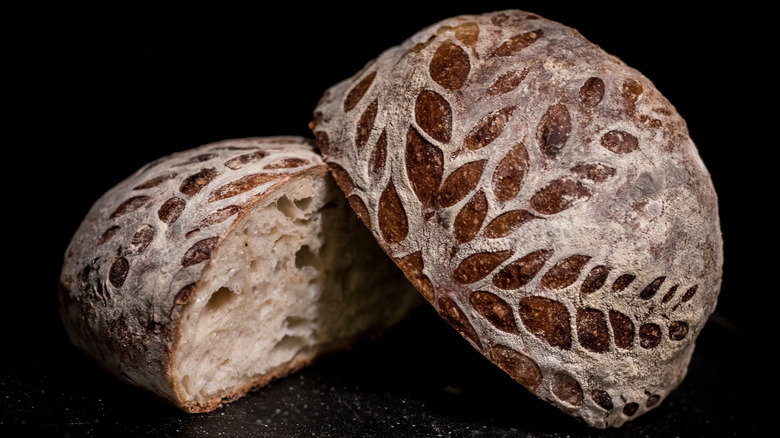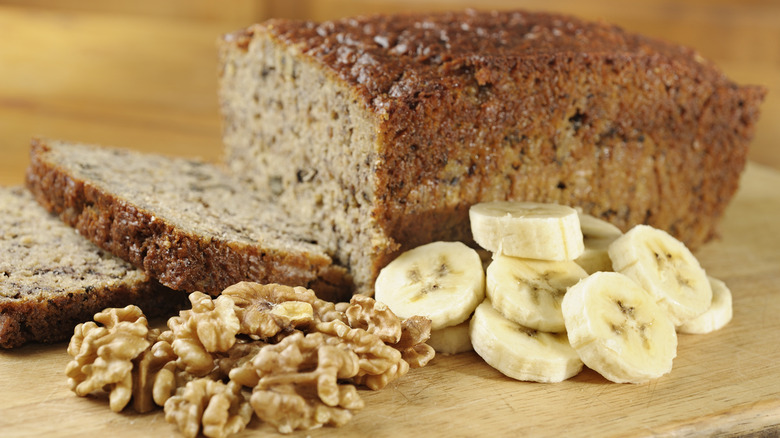Why It's So Important To Score Bread Before Baking It
One of the defining features of any crusty, rustic bread like a sourdough boule or baguette is its scoring. Scoring refers to slashes across the bread's crust, and it often serves as a way for the baker to lend an artistic touch of individuality to their loaves. Scoring can be simple, with a single line cut down the length of the bread, or it can be complicated, forming images of leaves, wheat stalks, flowers, and radial patterns all across the crust. If a baker hits it big on Instagram, it's usually thanks to the eye-catching scoring they deploy, but this step is more than an artistic flourish.
Scoring serves an important role in baking — it can make or break your bread. When you bake a freeform style of bread (that is, bread that's baked directly on a stone, hearth, or Dutch oven rather than in a loaf pan), you need to shape the dough by hand, and the final product should have a very taut surface for the bread to hold its structure. However, when that loaf hits the oven, gas (produced from the yeast) is forced out of it through a process known as oven spring. Scoring creates a place for this air to escape from. Otherwise, the surface of the loaf will explode as the hot gas tears your hard work apart.
The science of oven spring
Scoring is essentially a technique for controlling oven spring, so let's dive a little deeper into what, exactly, oven spring is. It has to do with the way yeasted breads rise. Yeast is a living thing, and just like us humans, it is constantly expelling carbon dioxide gas. This gas is what causes bread to rise, and although most of the rising process occurs outside the oven during the buildup to baking, there is always a final burst that occurs when you finally introduce the dough to heat.
This final, in-oven rising stage is called oven spring and typically happens within the first 10 minutes of baking. During this time, the sudden spike in heat causes the yeast to increase respiration, pumping out a large amount of carbon dioxide. The gas expands under heat, getting trapped within the gluten network of the dough and creating those beautiful air pockets we expect in a rustic loaf.
There is a limit to how much any loaf of bread can expand — eventually, some of the gas needs to escape. By slicing open the top of your loaf before baking, aka scoring, you provide a clear exit route for the gas, but if you don't score your bread, the carbon dioxide will break itself out by any means necessary. The built-up pressure will cause your bread's crust to rip apart at random. You may also see blowouts, which look like gigantic warts on the side of the loaf.
How to properly score bread
To save yourself from raggedy-looking crusts and blowouts, you should always score any type of freestyle crusty bread. There is a special tool designed for bakers to score bread called a lame (pronounced LAHM), which is essentially a curved razor blade. If you don't own a lame, you can use a standard, double-edged razor blade instead. The key is to use an extremely sharp blade, as a dull blade can snag on the sticky surface of the dough, creating rough, uneven scoring patterns.
There are a few techniques you can use when scoring bread. For beginning bakers, it's best to start simple with one or two long slashes that run lengthwise along the crust, or, if you're working with a round boule, forming a cross. It's important to make each slash in a single, rapid motion, as slowly dragging the blade through the dough can lead to snags and uneven lines.
As you gain experience, you can start experimenting with scoring in patterns using small slashes. One of the most popular scoring techniques for bread is to emulate a wheat stalk, and it's easier to do than you'd think. Starting from the top of the loaf, make a series of diagonal cuts, first going down the length of the loaf, then back to the top, like the V-shaped stitches on a baseball. It won't look like much at first, but oven spring will cause each little slash to expand into a beautiful leaf.
Not every type of bread needs scoring
Scoring bread is a vital step for some loaves, but not every kind of bread needs to be scored. If you're working from a recipe, it should specify on a case-by-case basis whether the type of bread in question needs scoring or not. Generally speaking, scoring is used for freestyle loaves with hard crusts that are baked at the highest temperatures your oven allows. Breads baked at lower temperatures don't need scoring because the oven spring effect is not as sudden and dramatic.
Since oven spring is caused by yeast, scoring is only necessary for yeasted breads, meaning that many varieties of quick breads, such as banana bread, are fine to bake without a slash. There will still be some air escaping, which is why banana bread has a crack in the top, but it's not the explosive disaster that can occur with sourdoughs and baguettes. Naturally, flatbreads such as pita, naan, and focaccia do not need scoring, as they do not rise dramatically, and bread made from high-hydration doughs is sometimes too wet to score in the first place. Again, follow the recipe guidelines, and if scoring is called for, use one of the techniques above to make your cuts.



